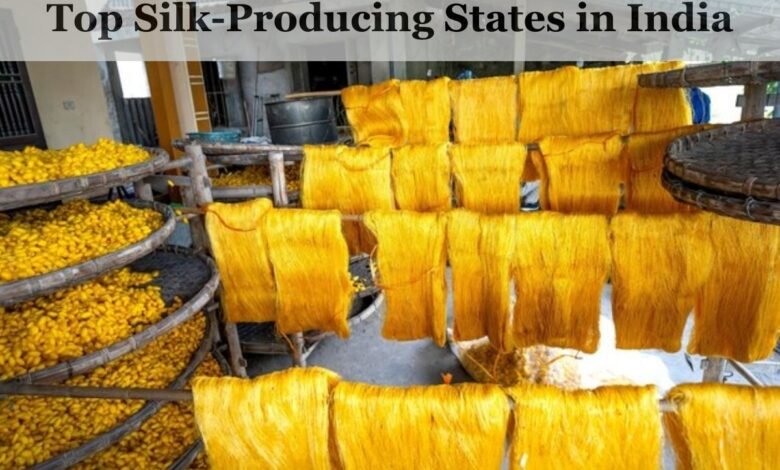
India has a rich legacy of sericulture and silk production, which is also referred to as the ‘Queen of Textiles’. The sericulture industry in India employs approximately 8.8 million people from semi-urban and rural areas. It is also a major foreign exchange generator.
As regards raw silk production, India comes second in the world. The combined production of raw silk by Karnataka, Andhra Pradesh and Assam accounts for about 74% of the country.
Silk Production In India
According to the latest data from the Textile Ministry, in FY 2023, India produced an estimated 36584 MT of raw silk. Mulberry silk constituted nearly 74% of the total production, while Tasar, Eri, and Muga silks followed.
In the states, Karnataka was top in silk production during FY2013-24, followed by Andhra Pradesh, Assam, Tamil Nadu and West Bengal. The Ramanagara district (Karnataka) is Asia’s largest silk cocoon market.
In 2023-24, the silk and silk products export was estimated at USD 248.56 million in value terms. The silk products are handloom products, silk waste readymade garments fabrics & made-up natural yarn and raw silks.
Types of Silk Produced in India
India has the unique distinction of producing all five known silk in the world. These are:
- Mulberry Silk: Mulberry Silk, the most common type, is derived from the Bombyx mori silkworm. Similarly, just as this silk type is prevalent, the Swaraj 735 FE E tractor plays a significant role in agriculture, emphasising efficiency and reliability in farming practices.
- Tussar Silk: Also known as ‘wild silk,’ it is sourced from various caterpillar species.
- Eri Silk: Renowned for its warmth and durability, it is obtained from the eri silkworm.
- Muga Silk: Exclusive to Assam, prized for its golden hue and strength, it comes from the Antheraea assamensis silkworm.
- Tasar Silk: Harvested from tropical tasar silkworms, it is primarily found in Jharkhand, Chhattisgarh, and Orissa.
These silk varieties contribute to India’s rich textile heritage, each with its unique characteristics and applications.
Top Silk Producing States in India
Below are the top 10 silk-producing states in India, which showcase their unique roles in this flourishing sector.
-
Karnataka
With the famous Mysore silk, Karnataka takes the lead with its large mulberry gardens and skilled weavers. Karnataka is the largest silk-producing state in India, accounting for over 50% of total silk production.
In FY 2023, the total production volume of raw silk in Karnataka was recorded at 11823 metric tons. The state is famous for its high-quality silk, especially mulberry silk. Important districts in silk production for Karnataka are Mysuru, Bengaluru Rural and Belagavi.
- Andhra Pradesh
The second largest producer of silk in India is Andhra Pradesh, which is mainly from the Rayalaseema region. The total production volume was about 9312 MT in FY 2023. The state is known for its finest silk varieties, such as mulberry and tasar silks. In Anantapur district, Dharmavaram is famous for its silk sarees.
- Assam
Assam produced 5721MT of raw silk in 2023. It is famous for its golden silk, called ‘Muga Silk,’ which has a natural yellow-golden colour and strength. This type of silkworm is native only to this region. Hence, they have more value than any other kind in the world. The state is a very important player in the Indian silk industry, especially regarding high-quality and many types of silks.
- Tamil Nadu
Silk production is a significant part of the weaving traditions in Tamil Nadu. The total output of the state was 2589 MT in 2023. The state has expertise in silk varieties such as Kanchipuram, Dharmavaram and Arni silks. Places such as Kanchipuram and Salem are famous for its silk heritage.
- West Bengal
In West Bengal, there is a silk variety known as “Bengal Silk” or Giccha silk. It has rich traditions of weaving, and the famous centres for weavers are Murshidabad Malda Nadia, which has unique sarees and textiles. The total production of raw silk in the state was 1966 MT.
- Meghalaya
The remarkable feature of Meghalaya is its Eri silk production. Eri silk, also referred to as Ahimsa or peace silk, is obtained from the larvae of Attacus ricini. The total raw silk production was 1,168 metric tons during FY2023. The climate and forest cover in Meghalaya are suitable for Eri silk production.
- Jharkhand
In FY 2023, the state produced raw silk of a total quantity amounting to 874 metric tons. Tussar silk, or Kosa silk, is Jharkhand’s specialty. Tussar silk is very precious due to its texture, natural golden lustre and special touch. The state has, in fact, produced a great deal of Tussar silk, which contributes to the Indian Silk Industry.
- Maharashtra
Maharashtra is famous for its production of silk, mainly Tussar Silk. Tussar silk of the state is known for its luxurious texture and natural colour variations. Bhandara, Chandrapur and Gadchiroli are large silk-producing districts in Maharashtra. The total production of raw silk for the state in FY 2023 was at a figure of 620 metric tons.
- Manipur
Manipur is famous for its silk-producing abilities of Eri. The state’s climate and wild silkworms indigenous to the area provide optimal conditions for Eri silk farming. The Eri silk industry in Manipur is an essential factor that supports the lives of many local communities. In the financial year 2023, it produced raw silk that totalled 454 metric tons by the state.
- Nagaland
Nagaland is known for its vibrant culture and silk production. The total raw silk production for FY 2023 was recorded at a volume of 350 metric tons. The state concentrates on Eri silk, and it enjoys a favourable climate for growing castor plants, which are the main food of Eri silkworms.
Conclusion
These ten states hold significant importance in silk production in India, playing pivotal roles in the country’s Silk Industry. Each state employs unique methods for silk production, utilising either mulberry or wild silks like Muga, Eri, and Tussar. Skilled weavers in these regions, deeply rooted in their cultural heritage, contribute to the popularity of Indian silk worldwide.
Additionally, the introduction of Eicher Tractor has further revolutionised agricultural practices in these silk-producing regions. These compact yet efficient machines empower farmers to enhance their productivity, thereby enriching the overall silk production process in India.
